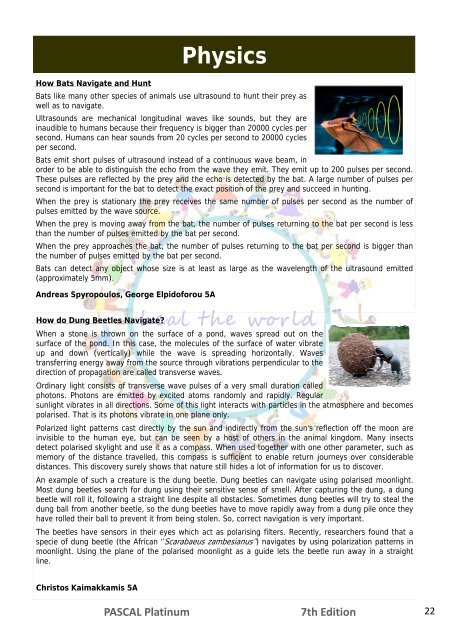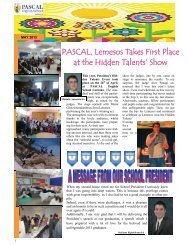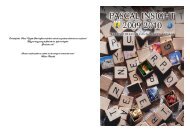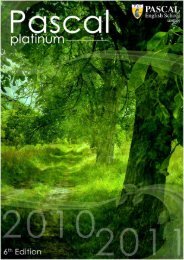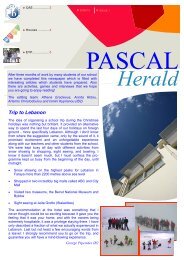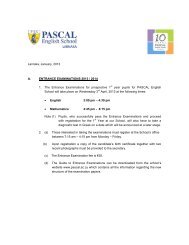PASCAL Platinum 7th Edition
PASCAL Platinum 7th Edition - Pascal Education
PASCAL Platinum 7th Edition - Pascal Education
- No tags were found...
You also want an ePaper? Increase the reach of your titles
YUMPU automatically turns print PDFs into web optimized ePapers that Google loves.
How Bats Navigate and HuntPhysicsBats like many other species of animals use ultrasound to hunt their prey aswell as to navigate.Ultrasounds are mechanical longitudinal waves like sounds, but they areinaudible to humans because their frequency is bigger than 20000 cycles persecond. Humans can hear sounds from 20 cycles per second to 20000 cyclesper second.Bats emit short pulses of ultrasound instead of a continuous wave beam, inorder to be able to distinguish the echo from the wave they emit. They emit up to 200 pulses per second.These pulses are reflected by the prey and the echo is detected by the bat. A large number of pulses persecond is important for the bat to detect the exact position of the prey and succeed in hunting.When the prey is stationary the prey receives the same number of pulses per second as the number ofpulses emitted by the wave source.When the prey is moving away from the bat, the number of pulses returning to the bat per second is lessthan the number of pulses emitted by the bat per second.When the prey approaches the bat, the number of pulses returning to the bat per second is bigger thanthe number of pulses emitted by the bat per second.Bats can detect any object whose size is at least as large as the wavelength of the ultrasound emitted(approximately 5mm).Andreas Spyropoulos, George Elpidoforou 5AHow do Dung Beetles Navigate?When a stone is thrown on the surface of a pond, waves spread out on thesurface of the pond. In this case, the molecules of the surface of water vibrateup and down (vertically) while the wave is spreading horizontally. Wavestransferring energy away from the source through vibrations perpendicular to thedirection of propagation are called transverse waves.Ordinary light consists of transverse wave pulses of a very small duration calledphotons. Photons are emitted by excited atoms randomly and rapidly. Regularsunlight vibrates in all directions. Some of this light interacts with particles in the atmosphere and becomespolarised. That is its photons vibrate in one plane only.Polarized light patterns cast directly by the sun and indirectly from the sun's reflection off the moon areinvisible to the human eye, but can be seen by a host of others in the animal kingdom. Many insectsdetect polarised skylight and use it as a compass. When used together with one other parameter, such asmemory of the distance travelled, this compass is sufficient to enable return journeys over considerabledistances. This discovery surely shows that nature still hides a lot of information for us to discover.An example of such a creature is the dung beetle. Dung beetles can navigate using polarised moonlight.Most dung beetles search for dung using their sensitive sense of smell. After capturing the dung, a dungbeetle will roll it, following a straight line despite all obstacles. Sometimes dung beetles will try to steal thedung ball from another beetle, so the dung beetles have to move rapidly away from a dung pile once theyhave rolled their ball to prevent it from being stolen. So, correct navigation is very important.The beetles have sensors in their eyes which act as polarising filters. Recently, researchers found that aspecie of dung beetle (the African ‘’Scarabaeus zambesianus’’) navigates by using polarization patterns inmoonlight. Using the plane of the polarised moonlight as a guide lets the beetle run away in a straightline.Christos Kaimakkamis 5A<strong>PASCAL</strong> <strong>Platinum</strong> <strong>7th</strong> <strong>Edition</strong> 22


